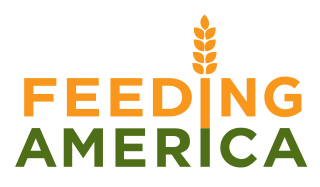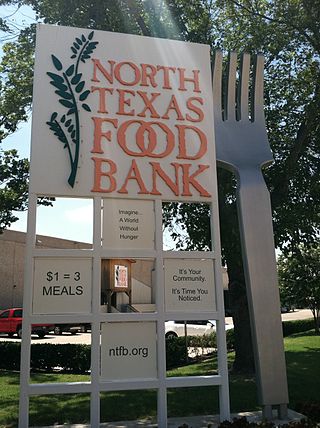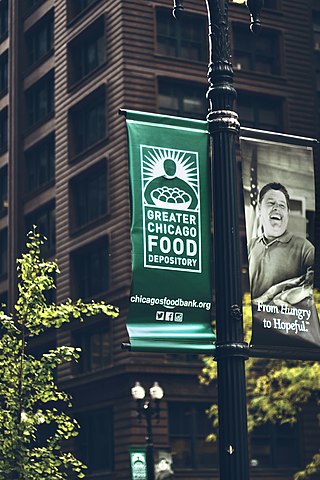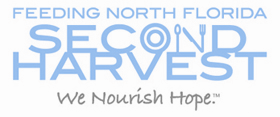The Alameda County Community Food Bank is a non-profit organization that supplies food to 400+ Alameda County, California agencies including food pantries, soup kitchens, child-care and senior centers, and after-school programs, provides an emergency food helpline, teaches nutrition and hunger education, and conducts outreach about California's food stamps program CalFresh. Located in Oakland, California, the food bank distributes enough food for 300,000 meals weekly. [1] Almost 50% of the food supply consists of fresh produce from California farms. [2] The organization is a member of the California Association of Food Banks, Feeding America, and the California Hunger Action Coalition. Their headquarters are at 7900 Edgewater Drive, next door to Oikos University. The food bank is in the former location of the book distributor Bookpeople.
According to 2010 census figures, 13.5 percent of the Alameda County population live below the poverty line and about 70 percent of students in the Oakland school district qualify for free or reduced-priced meals at school. The Alameda County Community Food Bank assists some of these students through their Children's BackPack Program. At the end of every other week, a bag of food is given to these students' families so they will have enough food for the weekend. [3] The Alameda County Community Food Bank works with CARD (Collaborating Agencies Responding to Disasters) to build their organizational disaster response capacity and share emergency readiness within their network of 275 service providers.

The World Food Programme (WFP) is an international organization within the United Nations that provides food assistance worldwide. It is the world's largest humanitarian organization and the leading provider of school meals. Founded in 1961, WFP is headquartered in Rome and has offices in 80 countries. As of 2021, it supported over 128 million people across more than 120 countries and territories.

In the United States, the Supplemental Nutrition Assistance Program (SNAP), formerly known as the Food Stamp Program, is a federal government program that provides food-purchasing assistance for low- and no-income people to help them maintain adequate nutrition and health. It is a federal aid program administered by the U.S. Department of Agriculture (USDA) under the Food and Nutrition Service (FNS), though benefits are distributed by specific departments of U.S. states.

East Oakland is a geographical region of Oakland, California, United States, that stretches between Lake Merritt in the northwest and San Leandro in the southeast. As the southeastern portion of the city, East Oakland takes up the largest portion of the city's land area.
Oakland Unified School District is a public education school district that operates a total of 80 elementary schools (TK–5), middle schools (6–8), and high schools (9–12). There are also 28 district-authorized charter schools in Oakland, California, United States, serving a total of 48,704 students across both district-run and district-authorized charter schools.

Catholic Relief Services (CRS) is the international humanitarian agency of the Catholic community in the United States. Founded in 1943 by the Bishops of the United States, the agency provides assistance to 130 million people in more than 110 countries and territories in Africa, Asia, Latin America, the Middle East and Eastern Europe.

Feeding America is a United States–based non-profit organization that is a nationwide network of more than 200 food banks that feed more than 46 million people through food pantries, soup kitchens, shelters, and other community-based agencies. Forbes ranks it as the largest U.S. charity by revenue. Feeding America was known as America's Second Harvest until August 31, 2008.

The North Texas Food Bank (NTFB) is a social benefit organization located in Plano, Texas. The organization distributes donated, purchased and prepared foods through a network of nearly 1,000 feeding programs and 400 Partner Agencies in 13 North Texas counties. The NTFB supports the nutritional needs of children, seniors, and families through education, advocacy and strategic partnerships.

Redwood Empire Food Bank (REFB) is a food bank on the North Coast of California which belongs to the Feeding America network. Its mission is to end hunger in its community.
Food Bank For New York City is a non-profit social services organization and the major hunger-relief organization working against hunger in the five boroughs. Its aim is to organize food, information and support for needy citizens of New York City.

The Greater Chicago Food Depository (GCFD) is a nonprofit organization that fights hunger throughout Cook County, Illinois. The GCFD distributes donated and purchased food through a network of 700 food pantries, soup kitchens, shelters and community programs, serving more than 800,000 adults and children every year. In fiscal year 2016, the GCFD distributed more than 70 million pounds of nonperishable food, produce, dairy products, and meat - the equivalent of more than 160,000 meals every day. Of the $96,883,955 spent in 2016, over 90% went to direct food distribution programs.
The Emergency Food Assistance Program (TEFAP) is a program that evolved out of surplus commodity donation efforts begun by the USDA in late 1981 to dispose of surplus foods held by the Commodity Credit Corporation (CCC). This program was explicitly authorized by the Congress in 1983 when funding was provided to assist states with the costs involved in storing and distributing the commodities. The program originally was entitled the Temporary Emergency Food Assistance Program when authorized under the Temporary Emergency Food Assistance Act of 1983. The program was renamed to The Emergency Food Assistance Program (TEFAP) in 1990.
International Disaster Emergency Service (IDES) is a 501c3 non-profit organization based in Noblesville, Indiana, United States that seeks to meet the physical and spiritual needs of suffering people around the world in the name of Jesus Christ. The organization is primarily funded by Christian Churches and Churches of Christ. Much of its relief effort is done through local churches and missionaries already in place in the countries needing assistance.
Hunger Task Force, Inc. is a non-profit, anti-hunger public policy organization in Milwaukee, Wisconsin. Hunger Task Force works to end hunger in Milwaukee County, Wisconsin by providing direct food delivery services, and works to end future hunger by advocating for fair and responsible administration of federal nutrition assistance programs.

The Healthy, Hunger-Free Kids Act of 2010 is a federal statute signed into law by President Barack Obama on December 13, 2010. The law is part of the reauthorization of funding for child nutrition. It funded child nutrition programs and free lunch programs in schools for 5 years. In addition, the law set new nutrition standards for schools, and allocated $4.5 billion for their implementation. The new nutrition standards were a centerpiece of First Lady Michelle Obama's Let's Move! initiative to combat childhood obesity. In FY 2011, federal spending totaled $10.1 billion for the National School Lunch Program. The Healthy, Hunger-Free Kids Act allows USDA, for the first time in 30 years, opportunity to make real reforms to the school lunch and breakfast programs by improving the critical nutrition and hunger safety net for millions of children. Healthy, Hunger-Free Kids Act and Michelle Obama were a step in transforming the food pyramid recommendation, which has been around since the early 1990s, into what is now known as "MyPlate".

There were 795 million undernourished people in the world in 2014, a decrease of 216 million since 1990, despite the fact that the world already produces enough food to feed everyone—7 billion people—and could feed more than that—12 billion people.

Hunger in the United States of America affects millions of Americans, including some who are middle class, or who are in households where all adults are in work. The United States produces far more food than it needs for domestic consumption—hunger within the U.S. is caused by some Americans having insufficient money to buy food for themselves or their families. Additional causes of hunger and food insecurity include neighborhood deprivation and agricultural policy. Hunger is addressed by a mix of public and private food aid provision. Public interventions include changes to agricultural policy, the construction of supermarkets in underserved neighborhoods, investment in transportation infrastructure, and the development of community gardens. Private aid is provided by food pantries, soup kitchens, food banks, and food rescue organizations.

Second Harvest North Florida (SHNF) is a 501(c)(3) non-profit organization located in Jacksonville, Florida, that performs food rescue and redistribution to partner agencies in one quarter of Florida's 67 counties. The charitable organization has been active for over 30 years.

St. Mary's Food Bank Alliance is a nonprofit, nonsectarian organization located in Phoenix, Arizona. Founded in 1967 by John van Hengel, St. Mary's was the first modern organization to operate using the food bank model, which spread throughout U.S. and the rest of the world. Today, St. Mary's is recognized as the world's first food bank.
Food insecurity is an issue affecting many American college students. While hunger in the United States affects all age groups, food insecurity seems to be especially prevalent among students. Studies have found that students of color are disproportionately affected. Students can be especially vulnerable to hunger during their first year, as it may be the first time they've lived away from home. The rising cost of education is another driver of food insecurity among students. Experiencing a period of chronic hunger can impact a student's mental health, and can lead to lower academic performance. Measures taken to alleviate hunger among students includes the establishment of food pantries in several US universities.

Midwest Food Bank is an American 501(c)(3) non-profit organization that gathers food donations, primarily from large companies, and distributes them to other non-profit organizations and disaster sites. Founded on a family farm in Bloomington, Illinois, in 2003, Midwest Food Bank began expanding in 2005 after contributing to disaster relief efforts for Hurricane Katrina. Currently, it operates ten locations in the United States and two internationally. As of 2021, it was the United States' thirty-ninth-largest charity and second-largest food bank by revenue; each month, it distributes more than $32 million worth of food to more than 2,000 other non-profit organizations.